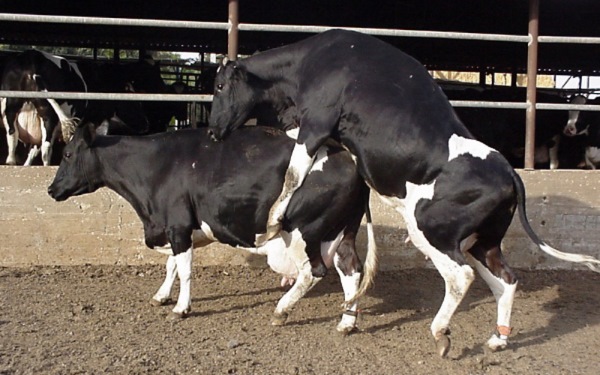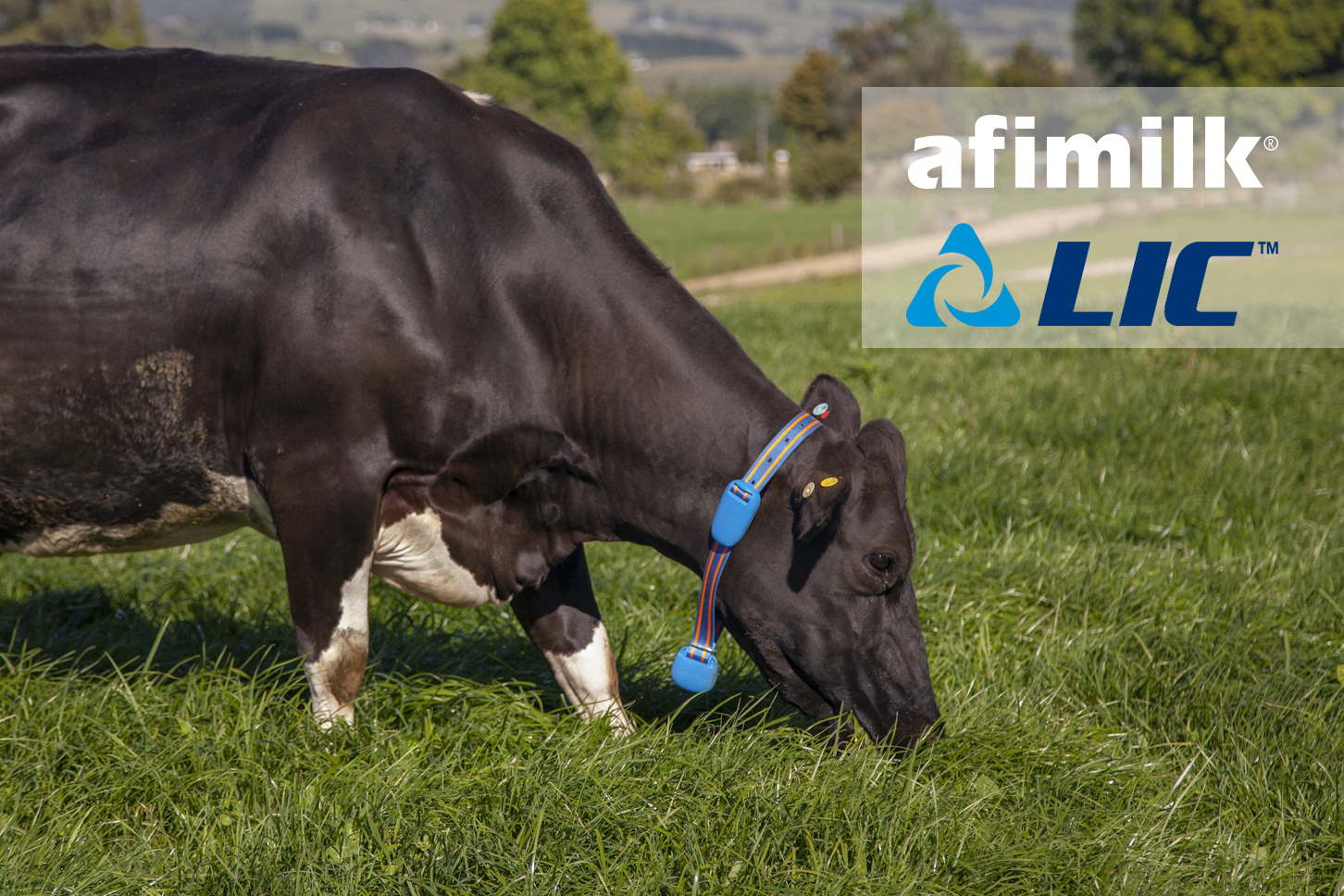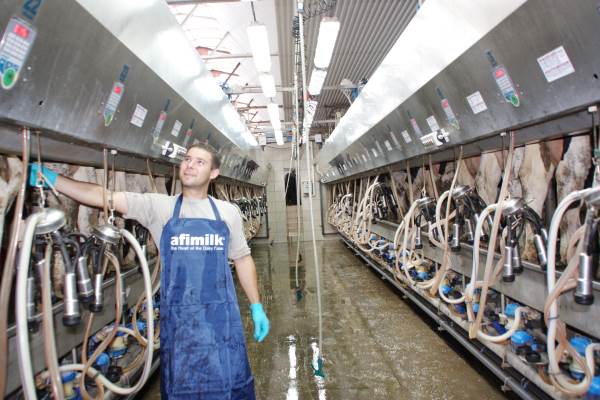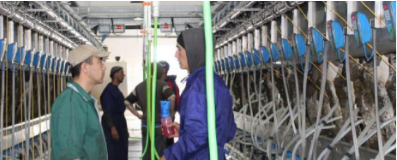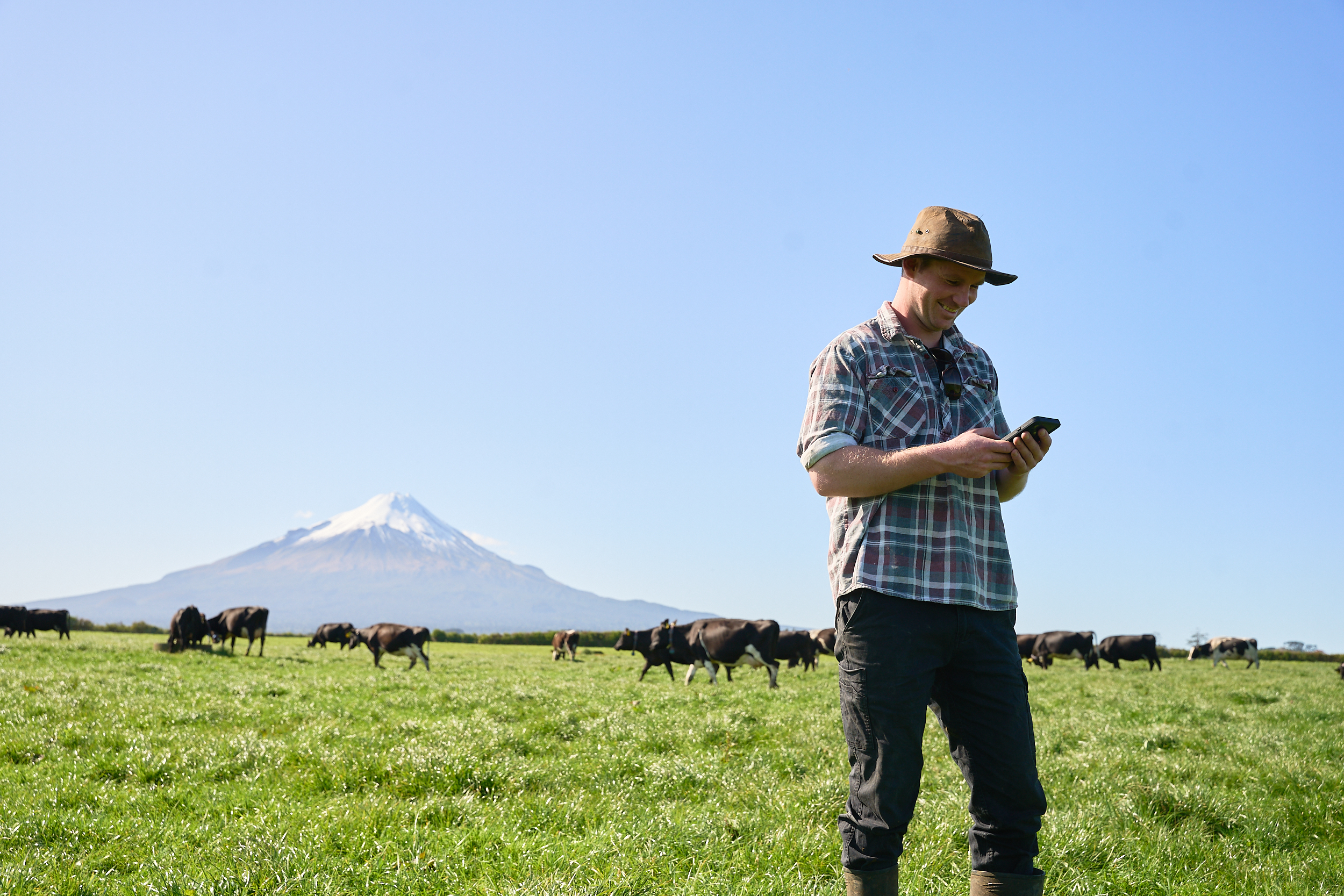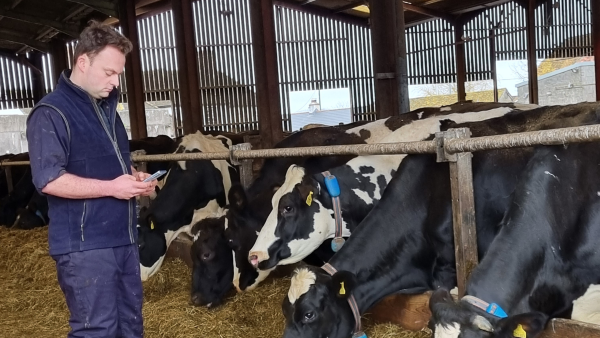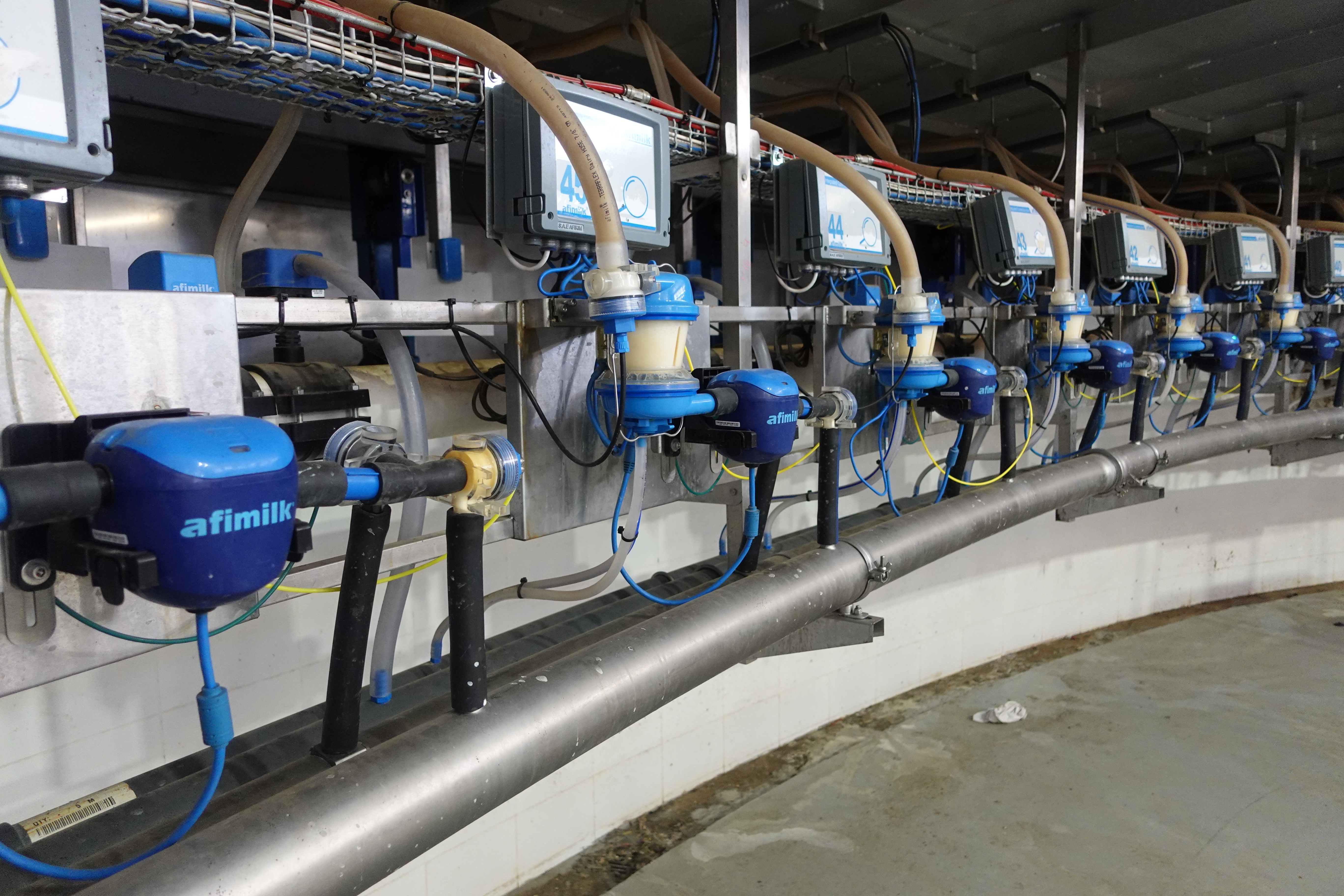By: Jody Muxlow
For: Dr. J. Kastelic
April 7th, 2005
This paper will outline the importance of estrus detection on the dairy farm. Signs of estrus, as well as, methods to detect estrus will also be covered. Finally the paper will focus on visual estrus detection and Pedometry as an alternate way for dairy farmers to detect estrus in the herd.
On the dairy estrus detection is the deliberate act to monitor and record the event of estrus and if artificial insemination (AI) is the method of reproduction, the breeding of the cow takes place at this time. Estrus is characterized as the period of sexual receptivity for the female (Senger, 2003). It is one of four phases of the estrous cycle. Proestrus and estrus make up the Follicular phase and metestrus and diestrus are in the Luteal phase.
The Follicular phase is the shorter of the two phases in the cow’s cycle and starts with proestrus with a decline of progesterone resulting from Luteolysis. Proestrus last approximately 2-5 days and is the transition from progesterone dominance to estrogen dominance. FSH and LH are the hormones responsible for this transition during proestrus as the reproductive tract is preparing for the onset of estrus and mating. The importance of estrus is that this is the period of time in the estrous cycle that the female is fertile and able to conceive when mating. In cattle the estrous cycle ranges from 17-24 days and estrus is considered day zero of the cycle. This is because it is the day that outward signs of the cycle are apparent. Heifers are in estrus for approximately 12-14 hours and mature cows are about 7 hours, although some animals may be in estrus for as little as 3 hours.
To simplify the estrous cycle, the cow is in estrus on day zero, by day 4 her uterus is preparing to receive an embryo moving down her fallopian tube for pregnancy. If conception doesn’t occur the uterus and ovaries prepare for another estrus characterized by day 17 of the cycle, where progesterone decreases and estrogen levels increase again (Sanders, 2000).
Detecting estrus and successful impregnating of a cow is the single most important factor on the dairy farm. When measuring reproduction and pregnancy efficiency the calving interval (CI) is the best measurement to evaluate the herd performance. The CI is the period of time between calvings measured in months. The target CI is 12 months but the actual average is13.5 months (Sanders, 2000). Increasing the CI means a decrease in overall milk production, and one less calf over the lifetime of that cow (OMAFRA, 2005). A CI of 12 months means that the cow is confirmed pregnant by 100 days of her lactation. Beyond this point profit loss per cow per day can range from $2.50 to $3.00 (OMAFRA, 2005). A regular CI is a major stimulant to high milk yield and maximum lifetime production as days open decrease milk production per day. This point stresses the importance of properly detecting estrus and breeding the cow at the appropriate time, research shows that missed estrus’s are responsible for an additional 40 days open (University of Maine, 2004). In North America losses related to poor reproduction equal $900 million annually.
Estrus lasts approximately 24 hours with a 12-hour window to achieve maximum fertility (Kastelic, 2002). On average the cow in estrus is mounted 9 times for approximately 3 seconds per mount, this means visual detection is 27 seconds per estrus period (Sanders, 2000)! This stresses the importance of proper estrus detection required to successfully catch a large percentage of animals in estrus.
The only way to properly manage reproduction is to measure the results of the individual herd. Ways to measure the effectiveness of estrus detection include: Days in milk at first breeding is a measure of early estrus detection.
Percent estrus detected is a calculation based on historical days open data and gives comparison information from previous herd statistics. Generally with good estrus detection this number should be greater than 70%.
Conception rate is a common measure and is the proportion of cows inseminated that are confirmed pregnant.
Pregnancy rate is the more accurate measure of efficiency because it is the product of conception rate and estrus detection, which means that it is the proportion of all the cows eligible to be bred that are pregnant (Kastelic, 2002). Consequently when estrus detection rates are low the pregnancy rate will also be low, so this calculation gives a better overall picture of the breeding management.
The most reliable behaviour symbolizing estrus is when the cow stands to be mounted by other animals. Conception rates are the highest when the cow is bred between 5 to 16 hours after the first mount (Kastelic, 2002). Other signs that characterize estrus include increased activity and restlessness, bellowing, slight swelling of the vulva, clear mucous discharge, and a decrease in milk production. Estrus detection methods most commonly employed by dairy farmers are:
- Visual observation
- Computerized systems like Pedometry or Heat Watch
- Chin ball markers
- Kamar Estrus Mount Detectors
- Teaser animals
- Progesterone tests
- Video taping
The focus of the paper is comparing visual detection to Pedometry, before this a brief description will be provided for number’s 3 through.
Heat Watch: Uses small radio transmitters placed in disposable patches and glued on to the tailhead of the cow. As mounting activity occurs a radio receiver collects and transmits the information to a buffer attached to the computer. The computer data indicates standing estrus, suspect estrus, non-return, inactive and brief cycles (Heatwatch.com, 2005).
Chin ball Markers (CBM): consist of a halter that holds a reservoir of paint and on the underside of the halter a roller ball marker that is similar to a giant ballpoint pen.
When the bull or the teaser animal equipped with the CMB mounts a cow in estrus, paint is applied to the rump and loins of the cow in estrus (Ensminger, 1997).
Teaser animals: are animals used to identify estrus; these animals are penile blocked bulls, vasectomized bulls, penis deviated bulls, caudal epidymectonmized bulls or andogenized females (NAAB electronic resource guide, 2005).
Progesterone tests: is a labor intensive detection aid because a milk or blood plasma sample is required. Cows at estrus should have low levels of progesterone in their system; a positive progesterone test would indicate low levels of progesterone in the blood or the milk. Unfortunately this test doesn’t evaluate the stage of estrus the cow is at, and is not an accurate way to evaluate when is a good time to breed the cow.
Videotaping: Cameras are setup in the barn and the herd is continuously monitored the tapes are reviewed for about one hour per day to detect cows in estrus.
This can be difficult on large farms with multiple pens to view, and also can be difficult to identify the cow in estrus depending on how far she is from the video camera.
The remainder of this paper will detail visual estrus detection and the accuracy and efficiency of this standard estrus detection method, as well as outline the use of Pedometry as a candidate to replace the use of visual estrus detection.
Visual estrus detection is considered the most accurate indication of estrus. Estrus is on average 13.5 hours. Feeding, lighting, and environmental temperature can influence the length of estrus. At the first mount the animal is approximately 5-16 hours from optimal conception. A positive estrus sighting is a cow standing to be mounted by other cows. However this can be a false indicator if the cow feels she can’t escape (Firk et al, 2002).
Visual estrus detection requires a minimum of two thirty-minute periods of uninterrupted observation. Accurate detection results in 81% of cows in estrus detected (U of Maine, 2004). Continuous estrus detection accurately accounts for 89% detected, which for the considerable amount of labor required it is only an 8% gain from twice a day observation system.
Although visual estrus detection produces the best results for detecting cows in estrus, the efficiency of visual detection is less than or equal to 50% and 5-30% of the cows inseminated are not in estrus at service (Kastelic, 2001). Many of the problems associated with the poor detection rates stem from the person doing the observation.
Problems include a lack or understanding of estrus behaviours, not being attentive, or trying to multi-task during the assigned estrus detection time. Estrus detection can be a somewhat subjective process and therefore a person may misread the situation and breed the cow that is not at the optimal time to conceive.
The importance of getting the cow pregnant has lead to the development of alternative estrus detection aids aimed to take the guesswork out of estrus detection for managers. The focus for the remainder of the paper will be about the development of Pedometry as an alternative to visual estrus detection.
A pedometer is a cow identification device that incorporates an activity meter.
The pedometer was developed to assist in improving estrus detection rates. Researchers knew that around the period of estrus a common characteristic exhibited by cattle is restlessness and increase in activity. In 1954 the first research found that cows had a 218% higher incidence of physical activity at estrus than in diestrus, proestrus, or metestrus (Nebel et al, 2000). Twenty years later research conducted indicated at estrus cattle housed in free stall barns had a 393% increase in activity, approximately four times their normal rate. Cattle housed with comfort stalls showed 2.76 times the increase in walking activity at estrus (Nebel et al, 2000). Averaging the results from several studies conducted on the efficiency of pedometer readings is 83%. The accuracy of declaring the cows in estrus is 85% (Nebel, 1998). Pedometer effectiveness for estrus detection has been compared the effectiveness of visual estrus detection carried out for 30 minutes or 1 hour, 1 to 3 times daily. However pedometers are not as effective as visual detection carried out for 60 minutes four times per day or six 30-minute observations (Kastelic, 2002). Although on most large dairy farms the labour required to carry out such extensive detection measures would be very costly for the marginal gains of only 8%. Realizing that the current estrus detection efficiency is less than 50%, it does seem that pedometers are a reasonable alternative to visual detection. Research data indicates that pedometer accuracy with successive ovulations post-partum is higher than those for visual estrus detection.
Insert Table Instead
The values are:
| Pedometer | Visual Detection |
|---|---|
| 1st ovulation = 57% | 1st ovulation = 19% |
| 2nd ovulation = 91% | 2nd ovulation = 97% |
| 3rd ovulation = 93% | 3rd ovulation = 79% |
(Firk et al, 2002)
The difference in the two methods can mean the difference in calving intervals and overall profitability of the herd.
The pedometer is attached to the cow’s leg, and measures the number of steps per hour. The increased activity is detected by the increased rate of electrical impulses, which are counted and stored in the pedometers circuitry. Current systems do not use real time data, so this means the cow must pass by an interrogation device to upload current data on the animal’s movement. This can be problematic because data is only being retrieved as the cow passes the sensors, so information may be loaded only a few times daily. The commercial pedometer developed by Afimilk Inc., was used to correlate steps per hour with other facts like cow age, parity, milk yield, and days in milk. Average diestrus activity was not related to any other animal characteristic, further showing the quantative value for Pedometry as a useful estrus detection device (Nebel et al, 2000).
Pedometer readings are most valuable when compared with other stages of the estrous cycle to positively detect estrus. This relates to the specificity of the pedometer reading and the ability to detect the cows that show very subtle signs of estrus, because she is deviating only from her own average.
To calculate the appropriate time to inseminate the cow, mathematical models and rectal palpation were used to figure out the appropriate time to breed after activity reading increased (Nebel et al, 2000). The beginning of estrus was determined to be the first two hour period when the mean pedometer value for the current 12-hour window which was two times the running means of the comparable period in the previous two days. The optimum time to breed was calculated to be 11.8 +_ 1.7 hours after the increase in pedometer activity (Nebel et al, 2000).
Possible problems that are associated with the pedometers include:
- No real time data, which means animals aren’t being detected right when activity increases
- High cost to implement system, as well as, training which is involved to learn how to analyze the data
- If animals movement is impaired deviation may not be recognized
- Pedometers can break or possibly fall off which would stop data from being collected
- Increase in activity could be related to something other than estrus
Pedometers are currently being used in larger dairy herds where computer data systems are replacing labor intensive jobs like estrus detection. This is due to the reliable and objective nature of the data generated. These farms are more likely able to afford to implement the pedometers and the accompanying software to better manage their herds. The pedometer systems are integrated with milking equipment and register each lactating cow’s activity, electro conductivity, milk weight, milk temperature, as well as other parameters the herd manager seeks to analyze.
Proper estrus detection is vital on dairy farms because it is the link to pregnancy and the greatest milk production for each cow. Due to the costly nature of inaccurately detecting cows in estrus, technology such as pedometers creates a genuine alternative to the labor intensive job of visual estrus detection.
Works Cited
- Senger, P. Pathways to Pregnancy and Parturition, 2nd Edition. Ephrata, PA: Current Conceptions Inc., 2003.
- Sanders, D. Milk Them For All Their Worth. Urbana, OH: VACA Resources, 2000.
- Ensminger, M. The Stockman’s Handbook, 7th Edition. Danville, IL: Interstate Publishers, Inc., 1992.
- Firk, R. , Stamer, E., Junge, W., Krieter, J. “Automation of Oestrus Detection in Dairy Cows: A Review.” Livestock Production Science 75 (2002): 219-232.
- Nebel, R., Dransfield, M., Jobst, S,. Bame, J. “Automated Electronic Systems for the Detection of Oestrus and Timing of AI in Cattle.” Animal Reproduction Science 60-61(2000): 713-723.
- Nebel, R. “Virginia Cooperative Extension.” Pedometry is Here as a Method of Heat Detection. May 1998. Virginia Tech. March 16, 2005.
- Marcinkowski, D. “U of M: Cooperate Extension.” Estrus Detection: Problems, Evaluations, and Solutions. April 2004. University of Maine. March 12, 2005.
- Kastelic, J. “WCDS Proceedings 2001.” Computerized Estrus Detection. 2001. Western Canadian Dairy Seminar. March 12, 2005.
- Murray, B. “OMAFRA Fact Sheet.” Maximizing Conception Rate in Dairy Cows – 1. Estrus Detection. March 1990. Ontario Ministry of Agriculture and Food. March 12, 2005 <https://www.gov.on.ca/OMAFRA/english/livestock/dairy/facts/84-048.htm>.
- Cooperative Extension Service. “The U of G College of Agricultural and Environmental Sciences.” Dairy Reproduction Benchmarks. March, 2002. TheUniversity of George. March 15, 2005
- Afimilk. Computerized Dairy Management Systems. March 3, 2005 <https://www.afimilk.com/>.
- Estrus Watch Inc. Home page. 2005. March 16, 2005.
- Grant, E. “NAAB Electronic Resource Guide.” The Estrus Is On. National Association of Animal Breeders. March 12, 2005 <https://www.naab-css.org/>.
